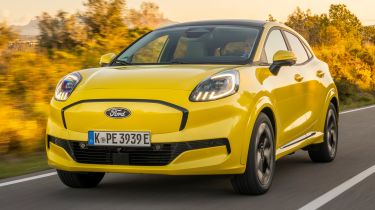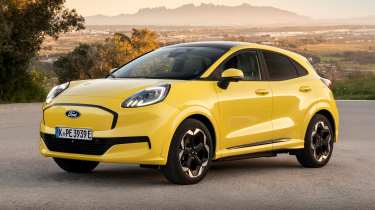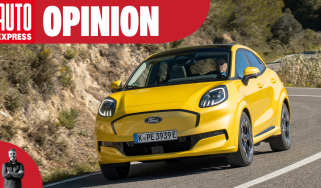Ford Puma Gen-E review
Despite being fun to drive and surprisingly practical, the Ford Puma Gen-E feels a little late to the game in terms of electric ability

Our opinion on the Ford Puma Gen-E
The Ford Puma makes a compelling case for itself in this all-electric ‘Gen-E’ format. Much of what we like about the petrol model’s driving dynamics remains with the Puma Gen-E, it is sensibly priced, and there’s a nice surprise with added storage space. It was efficient enough in our test to take attention away from its average range figures, although we still have reservations in this area and for charging. It may not remain competitive for long, either, given that this is the biggest battery the Puma’s platform can accommodate.
| Key specs | |
| Fuel type | Electric |
| Body style | SUV |
| Powertrain | 43kWh battery, 1x e-motor, front-wheel drive |
| Safety | 4-star Euro NCAP (updated 2025) |
| Warranty | Three years/60,000 miles |
About the Ford Puma Gen-E
Arriving in 2019, few could have predicted the success the Puma has had for Ford - especially in the UK where it’s had the best-selling top spot for the past two years. There’s been a glaring omission to the Puma’s spectrum of appeal which has arguably made its popularity all the more admirable: there’s been no pure-electric version, but Ford has plugged the gap by introducing the Puma Gen-E for 2025.
It’s the smallest electric car in Ford’s line-up and, for now at least, “the final part of the EV range” according to the brand. Sitting under the Ford Explorer, Ford Capri, and Ford Mustang Mach-E, the Puma Gen-E has some seriously tough competition in the shape of the Kia EV3, Vauxhall Mokka Electric, Peugeot E-2008, Volkswagen ID.3, Volvo EX30 and the award-winning Skoda Elroq.
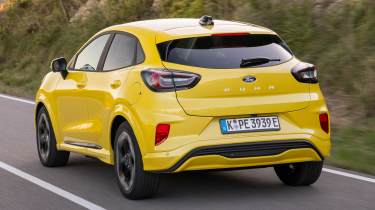
Despite the extensive rivals, Ford does have an ace up its sleeve: renewing customers. The brand expects 30,000 existing Puma customers to return to dealerships this year, with many of those being directed towards this EV. They’ll have to get used to a shortened trim level structure, however, with Select and Premium the only ones available.
Used - available now
Select kicks things off from £29,995 with the Premium costing £2,000 more. That means the Gen-E costs around £3,500 more than a basic petrol car with Ford’s 123bhp 1.0 EcoBoost engine. Opt for the automatic gearbox on the regular Puma, and the premium narrows to less than £2k.
Ford started working on the Gen-E alongside last year’s Puma facelift, so it gets broadly the same kit as the standard car with a dashboard that's dominated by a 12-inch touchscreen and a 12.8-inch digital driver’s display. There are a few bespoke tweaks for the EV, but existing facelifted Puma owners will find the Gen-E familiar inside.
Unlike some of its other pure-electric siblings, the Puma Gen-E doesn’t share its technical make-up with Volkswagen’s MEB EVs. Underpinning it is the same global B-car platform as the regular Puma, though Ford has managed to shoehorn in a 43kWh battery to provide a maximum range of 234 miles.
If you like the idea of owning a Ford Puma Gen-E, then our Find a Car service is here to help. You can also configure your ideal Ford Puma Gen-E and receive great offers from our network of dealerships, take a look at the best Ford Puma Gen-E leasing deals or choose from a huge selection of top-notch used Ford Puma Gen-E models. Need to sell your car? Be sure to visit our Sell My Car page.
Performance & driving experience

Pros |
Cons |
|
|
Our hopes are high for the Ford Puma Gen-E’s driving dynamics because it shares its architecture with one of the best-driving small SUVs out there. Instead of going to extremes and trying to make the Gen-E an alternative to the Ford Puma ST, Ford says that inspiration for the chassis set-up comes from the softer, entry-level Titanium instead.
The top-spec Premium sits on 18-inch wheels as opposed to the 17-inch rims on the Select. There’s a 19-inch option, but we’d be wary of the ride on them. We certainly don’t find the Puma Gen-E uncomfortable – it rides like the petrol car and it copes with speed bumps and large potholes pretty well. Comfort at higher speeds is good, too, although it'll occasionally be fidgety around town, with the damping not quite allowing the Puma Gen-E to settle.
It’s worth noting that, at 1,563kg, the Gen-E weighs almost 300kg more than the petrol version. Ford has managed to hide the extra mass well, though, because it’s genuinely adept.
Four driving modes are offered – Normal, Eco, Sport and Slippery – with steering and throttle response tweaks the most noticeable changes between them. Steering feel can be a little vague in Sport mode around town, especially just off-centre, but despite using a new steering rack system, it’s pretty similar to the regular Puma, which is a very good thing. In the ST, you get the option of a Handling Pack, which replaces the squared (Ford calls it the ‘squircle’) steering wheel with a round one. We wish this were offered in the Gen-E because the rim makes it hard to provide input smoothly.
The balance is nose-heavy and this gives it a rather exploitable feel in the bends, just like the petrol-powered Puma and Ford Fiesta before. There’s plenty of front-end grip to shrug off speed, and while there’s a bit more roll than we’d like, it’s all manageable and well communicated. The Puma Gen-E is certainly no hot or even warm crossover, but it retains a decent level of fun to its driving dynamics – certainly more than most of its rivals, at least.
On the more sensible side, the regenerative braking is well integrated into the brake pedal, with a balance of immediacy and smoothness, although you have to switch through too many menus on the screen to operate the one-pedal driving mode (changing the driving modes is similarly complicated).
Performance, 0-60mph acceleration and top speed
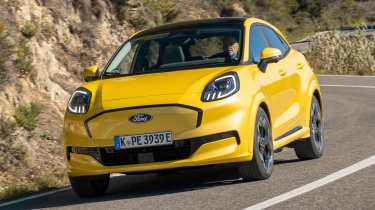
There’s just one electric motor option with the Gen-E, a front-mounted unit with 166bhp and 290Nm of torque – almost matching the 168bhp petrol-powered Puma ST. Despite its power, the Puma Gen-E takes 0.6 seconds longer to get to 62mph compared to its warm crossover sibling, with its top speed pegged at 99mph.
There’s instant torque in Sport mode, so it feels sprightly enough in everyday driving, but the motor can feel a little unresponsive at higher speeds. Sport also gives you a distant rumble through the speakers to give you a greater sense of what the car’s doing.
“The Puma Gen-E shares plenty of driving dynamics with the petrol car, and as a result, it’s one of the more engaging small EVs you can buy. Refinement on British roads could be tricky on cars with larger wheels, however.” - Alastair Crooks, Senior News Reporter
| Model | Power | 0-62mph | Top speed |
| Ford Puma Gen-E | 166bhp | 8.0 seconds | 99mph |
Range, charging & running costs
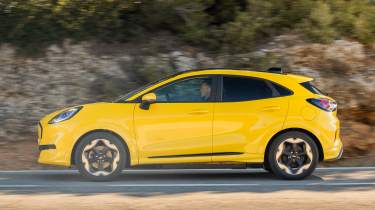
Pros |
Cons |
|
|
Nearly all of this Ford’s direct rivals have battery capacities of over 50kWh, so with its relatively small 43kWh unit, the efficiency of the Gen-E is vitally important. To coax out every last mile per kWh, Ford has tweaked the bodywork so that it cuts through the air more easily. At the front, there’s the customary blanked-off grille, combined with side air curtains in the bumper and active grille shutters below. The side skirts have been reworked, too, and the rear spoiler is lower and longer. Even the wheels are designed to be as aerodynamic as possible.
As we’ve said, the Gen-E is quite a bit heavier than the petrol car, but it’s still remarkably efficient. Ford claims the Puma Gen-E will return 4.7 miles per kWh, and we found that after an even mix of town, country and motorway driving, it would do a very impressive 4.3 miles per kWh. The issue is that despite the efficiency, you’ve only got a 43kWh battery to play with, so total range would have been only 184 miles. Even on a bad day, most of its rivals would easily cover more than 200 miles.
An area where the Puma scores well is insurance; group 19 places it well below the likes of the Volkswagen ID.3 and Kia EV3.
According to our expert data, the Puma Gen-E is expected to maintain around 50 per cent of its original value after a typical ownership period of three years or 36,000 miles. That's better than one of our favourite small electric SUVs, the Hyundai Kona Electric, which is expected to hang on to 45 per cent of its value over the same period. It's also much better than the Vauxhall Mokka Electric, which is worryingly only likely to be worth between 33 to 35 per cent of its original price over the same time frame, ouch.
No version of the Puma Gen-E costs more than £40,000 when new, so it'll avoid the luxury car tax penalty for those cars that cost more than this. Unfortunately, EVs like the Puma Gen-E are no longer exempt from vehicle excise duty (VED) fees, so you'll need to pay £195 annually for the privilege of driving it on UK roads. At least it will make for an affordable company car, with a three per cent benefit-in-kind (BiK) rate for company car drivers.
Electric range, battery life and charge time
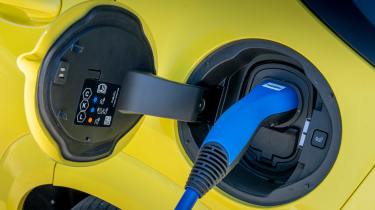
Considering its relatively low range, you’ll be charging the Puma Gen-E more often than most. The peak maximum charging speed stands at an average 100kW, and it takes 23 minutes to top up 10 to 80 per cent. As standard, you get a type 2 charging cable, which can be neatly tucked away in the 43-litre area under the bonnet.
Ford covers the battery under a separate eight-year, 100,000-mile warranty, which stipulates that they'll replace the battery pack if its capacity drops below 70 per cent during that period. You get two-year, unlimited-mileage service intervals between trips to the dealer, much like you'll find on most Volkswagen ID electric cars. You also get free recovery to the nearest charging station if you run out of juice on the road.
| Model | Battery size | Range | Insurance group |
| Ford Puma Gen-E Select | 43kWh | 234 miles | 19 |
Interior, design & technology

Pros |
Cons |
|
|
The Puma Gen-E doesn’t look too dissimilar to the petrol car, and that’s the point. Ford knows that it’s probably best not to alienate its existing customers with a wild new EV, so taking the incredibly popular Puma and making it electric seems to be a smart move. There's an eye-catching and suitably named Electric Yellow paint for £800 that’s exclusive to the Gen-E, or you can have black, silver, red or blue. Frozen white remains the free colour option.
The interior is pretty similar to that of the petrol car, but there’s a redesigned centre console which has removed the manual handbrake and gearlever, and replaced them with a column-mounted stalk. This frees up extra space on the console for three cupholders and a large wireless charging pad.
Infotainment, sat-nav and stereo

The Puma Gen-E’s infotainment is the same as you’ll find in the facelifted Puma. It comes with Ford's bespoke SYNC4 system, which includes Amazon Alexa voice control. The layout of the infotainment’s menus is pretty easy to get your head around, and the system itself is responsive. The one downside is that the in-built sat-nav isn’t the best in its class, with a bit of lag and some rather simplistic mapping.
Occupying a 12-inch screen, all of the car’s climate and audio controls have been integrated, so the dash looks neater, but less ergonomic than the old Puma. We like the physical buttons mounted on the steering wheel, though, and the driver’s display places a focus on the most important readouts, with an easily-accessible trip computer.
“The large dual-screen set-up in the Puma gives the dash a flashier look than older cars, but it comes at the cost of usability. Apple CarPlay and Android Auto are recommended for sat-nav usage.” - Alastair Crooks, Senior News Reporter
Boot space & practicality
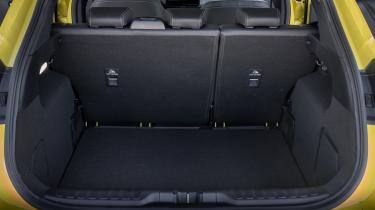
Pros |
Cons |
|
|
Being one of the smaller entrants to the B-segment electric crossover group, the five-seat Puma Gen-E is unsurprisingly not the roomiest inside. Front occupants won’t have any issues with headroom and general space, but in the back, there’s a raised floor because of the battery, so your thighs are angled up. Headroom isn’t great back there, either.
There’s a bit of space underneath the reshaped centre console, some storage under the central armrest and decent-sized door bins, but overall interior storage is fairly average for the class in the Puma. There’s also a useful 12-volt socket in the boot area to power a range of accessories, and on the back row, you’ll find two Isofix points for child seats.
| Dimensions | |
| Length | 4,186mm |
| Width | 1,805mm (1,930mm inc mirrors) |
| Height | 1,536mm |
| Number of seats | Five |
| Boot space | 556-1,283 litres |
Dimensions and size

The Puma Gen-E is 114mm shorter and sits 24mm lower than the Kia EV3. It’s also smaller than the family hatch-sized Volkswagen ID.3 and significantly smaller in every dimension than the Skoda Elroq. The body of the Gen-E is taken from the regular petrol car, so you get a swept-back roofline and rounded proportions for a sporty look.
Boot space
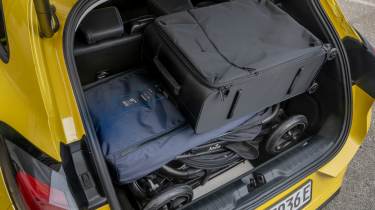
Ford has managed to free up even more space than you’ll find in the petrol car. All-in, the Gen-E has a Peugeot E-2008-beating 556 litres of space. That figure includes a huge 145-litre ‘Gigabox’ (the petrol car gets a 65-litre ‘Megabox’) beneath the boot floor, with a handy drain plug included. A 43-litre well sits under the bonnet – big enough for a toolkit or charging cable. There’s a bit of a lip to the boot, but given the crossover proportions, it shouldn’t be difficult to raise heavy items over it.
“The Ford’s headline boot figures are impressive - even though it doesn’t come in one immediately accessible area. There aren’t that many clever storage solutions in the cabin, which limits its family-friendly appeal.” - Alastair Crooks, Senior News Reporter
Reliability & safety
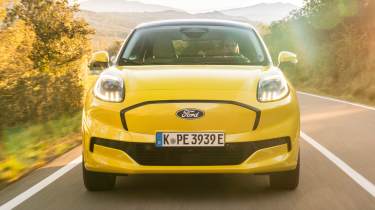
| Pros | Cons |
|
|
Given that the Puma Gen-E’s battery and electric motor combination haven’t been used in any other car as yet, it’s difficult to predict reliability for Ford’s latest offering. The firm’s oldest EV in its current line-up, the Mustang Mach-E, hasn’t had many issues with reliability since its launch in 2020, though.
In 2024, Ford finished a disappointing 30th in the Auto Express Driver Power customer-satisfaction survey, but they've improved this to rank 23rd out of 31 brands in the 2025 survey. That places the brand four positions higher than Volkswagen, but three spots down from Hyundai.
Owners weren't particularly complimentary about the regular Puma, though, as it ranked 47th out of the 50 cars included in the survey. They liked the styling and practicality of their Pumas, but reliability was a concern. Hopefully, the fewer moving parts of an EV will mean the Puma Gen-E should perform better. During our testing we found that overall build quality was solid.
Safety organisation Euro NCAP have conducted additional crash tests in 2025 with the Puma Gen-E, but it still retains the downgraded four-star rating of the regular Puma. That matches many other small electric SUVs like the Hyundai Kona Electric and Vauxhall Mokka Electric, but falls behind the MGS5 EV, which scored higher and got a five-star rating.
The list of standard safety kit is good, with cruise control with an Intelligent Speed Limiter, Driver Alert, Lane-Keep assist, pre-collision assist, rear parking sensors, a rear-view camera and speed sign recognition. The optional Driver Assistance Pack adds lane centering, predictive speed assist, lane-change warning and a 360-degree camera.
| Key standard safety features | Euro NCAP safety ratings |
|
|
Buying and owning
Best buy: Ford Puma Gen-E Select
While it might be tempting to go for the range-topping Premium trim, we’d stick with the entry-level Select model. It has a marginally longer range thanks to its smaller 17in wheels, and it keeps the price competitive with its rivals. The reasonably priced Winter pack is a worthwhile addition for £350 to get heated seats and a heated steering wheel, and if you really want some additional driver assistance technology, you can add the Driving Assistance pack for £950, and still save yourself some money compared with the top-of-the-range trim.
Ford Puma Gen-E alternatives
Almost every mainstream manufacturer has a rival to the Puma Gen-E. There’s the suite of Stellantis siblings, such as the Vauxhall Mokka Electric, Peugeot E-2008 and the more upmarket Alfa Romeo Junior, for example. All beat the Puma for range, though only the Alfa would be able to rival the Ford for driving enjoyment. Other offerings include the excellent Kia EV3 and the spacious Skoda Elroq, not to mention the Renault Megane E-Tech (which recently got a price reduction) and the classy Volvo EX30.
Deals on the Ford Puma Gen-E and alternatives
Ford Puma Gen-E pictures
Frequently Asked Questions
The Ford Puma Gen-E has a maximum range of 234 miles

